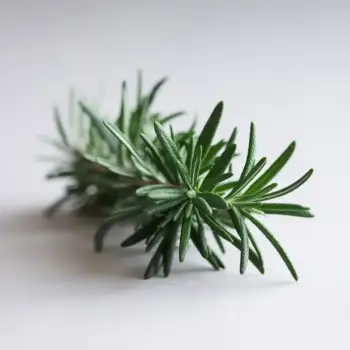Rosemary and Thyme are aromatic herbs popular in cooking for their distinctive flavors. Rosemary is robust and pungent, suitable for hearty dishes like roasted meats and potatoes. Thyme is subtle, with earthy, minty notes, ideal for lighter fare such as chicken, soups, and vegetables.

Rosemary is an evergreen herb with needle-like leaves. It's robust, pungent, and slightly bitter, with a woodsy aroma that makes it a favorite in Mediterranean cuisine.

Thyme is a small, perennial shrub with tiny leaves. It offers a subtle, earthy flavor with minty and lemony notes that complement a wide variety of dishes and cuisines.
Rosemary has a stronger, more assertive flavor compared to Thyme's gentle whisper. With its woody texture, rosemary stands up to longer cooking times, whereas thyme's delicate leaves are often used fresh or added at the end of cooking. While both herbs are Mediterranean in origin, thyme grows in a variety of climates, making it more globally available.

Your ultimate Recipe Box, Meal Planner, and Cooking Class all in one
Best in roasted meats like lamb, potatoes, and root vegetables. Its hearty flavor withstands high temperatures and infuses the dish with a robust taste. Great for subtly flavoring roasted chicken, fish, or vegetables. It adds a nuanced, earthy tone without overpowering delicate flavors.
Perfect for hearty stews and soups, such as beef stew or minestrone. Rosemary stands out and complements rich, savory flavors. Ideal for lighter soups and stews, including chicken soup or vegetable broths, where it imparts a subtle depth without dominating.
Delicious in focaccia, breadsticks, and savory scones, where its bold flavor can shine through the doughy textures. Excellent in flaky pastries, biscuits, and as a complement to lemony and cheesy flavors in baked goods.
Both Rosemary and Thyme are low in calories and contain various vitamins and minerals, making them a healthy addition to any dish.
| Nutrient | Thyme ( per 2 teaspoons ) | Rosemary ( per 2 teaspoons ) |
|---|---|---|
| Fat | 0.1g | 0.1g |
| Fiber | 0.4g | 0.3g |
| Protein | 0.1g | 0.1g |
| Calories | 2 | 2 |
| Vitamin C | 1.3mg | 1.2mg |
| Carbohydrates | 0.6g | 0.4g |
While they can be substituted, caution is required due to the difference in flavor strength. Use less rosemary than thyme, and more thyme than rosemary when substituting.
Not always. They have distinct flavors and should be chosen based on the dish's desired taste profile.
Rosemary pairs well with roasted meats, potatoes, and heartier dishes due to its robust flavor.
Thyme is versatile and goes well with chicken, fish, soups, and stews, especially when a subtle flavor is desired.
Both should be stored in a refrigerator, wrapped in a damp paper towel, and placed in a plastic bag for maximum freshness.
Dried herbs are more concentrated in flavor, so use them in smaller quantities. The general rule is to use one-third the amount of dried herb to fresh.